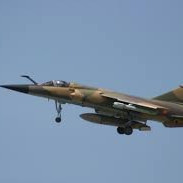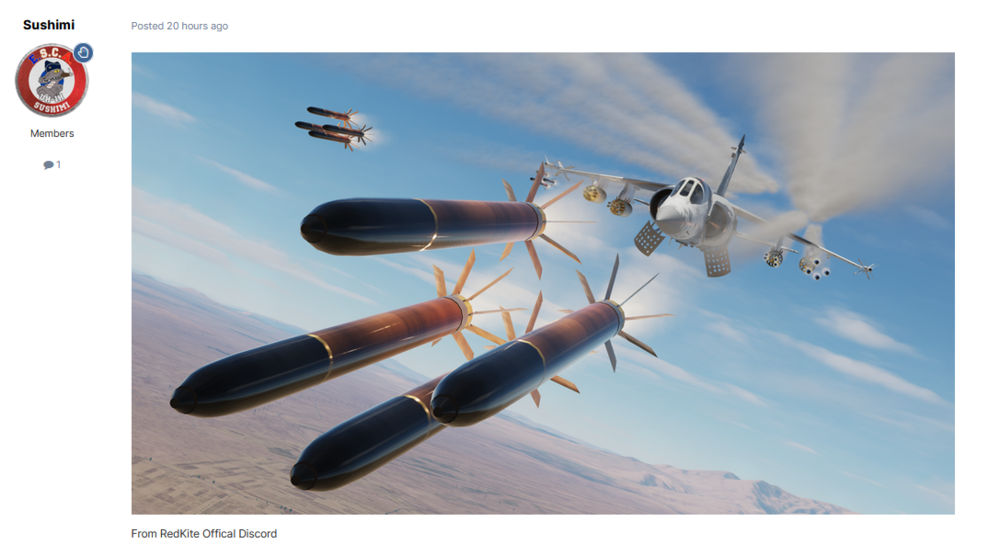-
Posts
40 -
Joined
-
Last visited
Content Type
Profiles
Forums
Events
Posts posted by M F1
-
-
Tutorial from Redkite :
RWR and Countermeasures in Mirage F1-CE :
-
 5
5
-
 1
1
-
-
Tutorial from Redkite :
RWR and Countermeasures in Mirage F1-CE :
-
 2
2
-
-
- Post by Sushimi on
- Home English Digital Combat Simulator DCS World 2.7 DCS: Roadmap (unofficial - NO DISCUSSION HERE)
-
 4
4
-
 1
1
-
as Jack's son would say .... No you're not alone !!!

it is true that many of us on this forum are looking for any information... hoping to know when this bird will finally be available in DCS
-
 4
4
-
-
Regarding the Mirage F1 radar, below is the link to a post explaining the origin of the Cyrano IV but above all its operating mode.
It is explained that this radar has 3 modes :
1/ Air/Air
2/ Close combat mode (Canon and Magic)
3/ Air/Ground (visualization by radar of the terrain in front of the aircraft)The adjustment of the radar being done from a specific joystick .
The Air/Air mode is broken down into 4 phases :
- search for the target
-target lock
-pursuit phase (bringing the aircraft into a firing position of -the armament on the target)
avoidance of the target after the shot (clearance).https://www.secretprojects.co.uk/threads/cyrano-radar-family.37016/
No doubt that some will be able to complete these explanations
-
 1
1
-
-
Regarding the Mirage F1 radar, below is the link to a post explaining the origin of the Cyrano IV but above all its operating mode.
It is explained that this radar has 3 modes :
1/ Air/Air
2/ Close combat mode (Canon and Magic)
3/ Air/Ground (visualization by radar of the terrain in front of the aircraft)The adjustment of the radar being done from a specific joystick .
The Air/Air mode is broken down into 4 phases :
- search for the target
-target lock
-pursuit phase (bringing the aircraft into a firing position of -the armament on the target)
avoidance of the target after the shot (clearance).https://www.secretprojects.co.uk/threads/cyrano-radar-family.37016/
No doubt that some will be able to complete these explanations
-
 3
3
-
 2
2
-
-
-
1 hour ago, Mike Force Team said:
I like it. I like it.
 We want it. We want it.
We want it. We want it.
@M F1 It must be exciting to develop and beta test the the jet. We look forward to flying it whwn it is available.
MFT
Don't get me wrong, I don't have access to the test version.
I only share your interest in this plane and and more particularly in this project.
Can't wait to fly on it

-
ask for the program !
some information on the next themes of future Redkite tutorials

-
 2
2
-
 1
1
-
-
A new tutorial video from Redkite :
Mirage F1CE TACAN Navigation Tutorial
-
 9
9
-
 2
2
-
-
-
15 hours ago, turkeydriver said:
Me thinks the Radar CRT is functional.......
Please turkeydriver,
tell us more about what you know about the WIP of this radar

-
 1
1
-
-
Regarding the tutorials :
For information, Redkite's comment on Youtube...

-
 5
5
-
-
Here are the different videos on the baby of Aerges
the next videos will be added there... including those of ASMR from Mirage F1

- Tutorials :
by RedKite :
F1CE Take off, Landing, Flight Tutorial
F1CE TACAN Navigation Tutorial
F1CE Rockets, Bombs and Guns Ground Attack
- Project description :Aerges Interview about F1 - Mineralnye Vody Airshow Oct 2021
- Teasers :
-
 6
6
-
 4
4
-
The Mirage F1 was able to carry an anti-radar missile.
This is an anti-radiation called ARMAT. Developed by the MATRA company from the AS37 surface-to-air missile, it was only used on F1 by the Iraqis against Iran in the second half of the 1980s.
Pulled only from the F1-EQ, version not planned by AERGES (according to what has been announced to date).
-
On the latest Redkite video, two other pieces of information :
- there is a guide: you can see an extract on this second video at 5min07s
- as you might expect, Redkite announces a series of tutorials (including relighting the engine in flight)

-
 2
2
-
-
Here is a new Red Kite tutorial on takeoff and landing on Mirage F1-CE

Link to Youtube; https://www.youtube.com/watch?v=0sz78SNnLrA
-
 2
2
-
 3
3
-
-
a new tutorial on the F1-CE is in preparation by Redkite... and maybe even this week !
See below the announcement made yesterday by Redkite in the comments of his first video on the F1 Mirage

-
 7
7
-
-
it's almost Christmas...
-
 2
2
-
-
Los Llanos (Spain) air base :
The first Mirage F1s arrived in Spain in June 1975 at Los Llanos air base in Albacete (300 km southeast of Madrid). But I have no information on the names of the first pilot except that it was probably not Don Quijote de la Mancha.
This air base previously dedicated to transport was dedicated to air superiority with the arrival of the Mirage F1-CE. For this was created Wing 14 (Ala 14) in 1975 and its 141 squadron which hosted these aircraft. Subsequently, in 1980, a second squadron, the 142, was born on this base.
On this aerodrome, the pilots achieved 100,000 flight hours on the French-designed aircraft in 1991. Subsequently, the air base received the first copies of the modernized F1-M version in 1999. These gave way to the Eurofighter in 2013.
In addition to the long period of use by the Spanish Air Force of the Mirage F1 on this air base (almost 40 years), another national particularity ; the Mirage F1 could be equipped with a locally manufactured bomb, the BR-250 (EXPAL).
@Vibora : Don't worry, the BR-250 will be enough to arm the plane. There will be no need to send you Manchego to do new armament tests...

-
From what I could read, the Mirage F1EE first had the RWR "BF" then for some an AN/ALR-300 system (shortly before the modernization in version M)
The RWR Sherloc was used for the F1CT (ground attack version derived from the F1 CR) and the F1 EQ6 (latest Iraqi version)
-
I hope the following does not concern mirage III...

https://pyrodine16.rssing.com/chan-9282860/article8.html
" The first Mirage F-1s that entered service in France in 1973, corresponding to the F-1C ("pure fighter") variant, were equipped with the Cyrano IV-0 radar, the basic version dedicated exclusively to air-to-air functions. Shortly after they were upgraded to the Cyrano IV-1 level incorporating some MTI (Moving Target Indicator) modes, which give it a certain "look down-shoot down" capability for the use of semi-active air-to-air missiles. This version is also called “Gnome Clutter”. In these first two versions, the performance was not very good in bad weather, so it was recommended to use it at high altitude, above the cloud layer, being able to intercept at supersonic speed.
Starting with the Cyrano IV-2, simple air-to-ground modes such as a mapping mode were included and approved to guide the new Super 530F semi-active missile that was just beginning to be incorporated into the Armee de l'Air.
A later Cyrano IV-3 version standardized the capabilities of the earlier models.
With the appearance of the Mirage F-1E, versatile for export, the much improved Cyrano IV-M entered service, which includes air-sea modes, ground mapping, contour mapping and air-ground telemetry, plus the inclusion of some filters for defeat certain electronic countermeasures. Also included is the ability to launch AS.30 air-to-surface missiles and Martel anti-radar missiles, while radar readings are now displayed on a real HUD, the Thomson CSF VE-110 or 120 replacing the old electromechanical sight.
Throughout its career, the Cyrano IV radar has used external aids to counter electronic countermeasures. These are the ECM pods that have appeared since the early 1980s as the Barracuda, followed by the Barax, the Remora, and then the Cayman. Said equipment deserves a detailed analysis that exceeds this note and will be dealt with in a timely manner, but we will say that they are carried externally on an underwing support and are passive and/or active interference systems. Although it is equipment that entered service more than 20 years ago, many were conveniently updated, such as the Barax carried by the Spanish Mirage F-1M. "
and also about phases of use of the Cyrano IV radar :
-
 1
1
-
-
Thanks

-
-
 2
2
-













About Mirage F1
in Aerges
Posted · Edited by M F1
added link to new video
Here are different videos on Mirage F1 of Aerges
by RedKite :
F1CE Cold Start Tutorial
F1CE Take off, Landing, Flight Tutorial
F1CE TACAN Navigation Tutorial
F1CE Rockets, Bombs and Guns Ground Attack
F1CE Radar + A/A Weapons
F1CE RWR and Countermeasures
By Spudnocker First Impression & Flight
in french :
by TheSkyline35 - Présentation
by groupement de Chasse 22 -Mise en route du Mirage F1 CE
by MG - 01 - Démarrage et décollage
in spanish :
by OVERSPEED Radar y combate aire aire + MISION
Preview may 2021
Mirage F1 Teaser Dec 2021 Aerges/ DCS
Spin march 2021